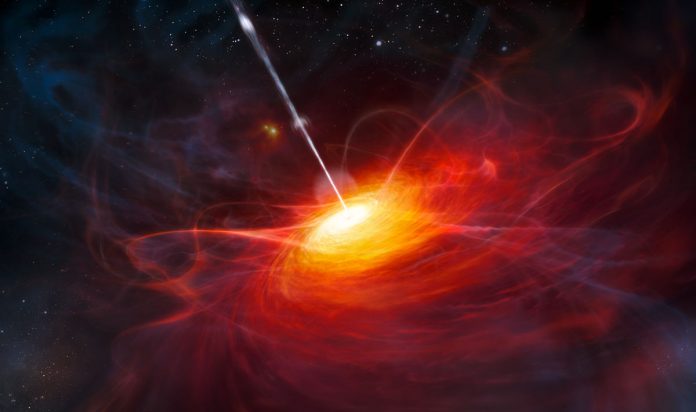Scientists have discovered about 750,000 quasars, which are among the brightest and most energetic objects in the universe. Despite its uninspiring designation, J0313-1806 is distinct from other quasars. This recently spotted object is the oldest known quasar in the universe, with a supermassive black hole more than 13 billion years old. In fact, it’s so old and huge that scientists don’t know exactly how it could have formed.
The first quasars were discovered in the mid-20th century, but it wasn’t until several decades later that we began to understand what these objects were. A quasar is an active galactic nucleus in which the supermassive black hole that anchors the galaxy pulls in matter to form a gaseous accretion disk. All this matter colliding as it spirals into the black hole releases a torrent of electromagnetic energy that serves as the hallmark of these objects. J0313-1806, for example, shines 1,000 times brighter than our entire galaxy.
J0313-1806 is far away — 13.03 billion light-years to be exact. That means we’re seeing this object as it was just 670 million years after the Big Bang, and it’s still huge. Astronomers estimate J0313-1806 to have about 1.6 billion solar masses as its observed age. That’s not out-of-line for a supermassive black hole elsewhere in the universe, but they’ve had longer to vacuum up matter and grow larger. J0313-1806 shouldn’t have had time in the early universe to grow so large.
The team used ground-based instruments like the Atacama Large Millimeter/submillimeter Array (ALMA) and the Mauna Kea Observatories (MKO) to spot J0313-1806 last year. It unseated the previous record-holder for oldest quasar, which is about 20 million years younger. Current models of black hold formation assume a star collapses to form a singularity, but the “seed mass” for J0313-1806 would have had to be at least 10,000 solar masses to reach 1.6 billion so quickly.
The study puts forward a hypothesis to explain the existence of this bizarre quasar, known as the direct collapse scenario. In this model, it wasn’t a star collapsing that formed the supermassive black hole. Instead, an enormous cloud of cold hydrogen gas collapsed inward to form a much larger black hole than any stellar source could produce. This could explain why astronomers see so many gigantic black holes in the early universe.
Unfortunately, J0313-1806 is so distant that we can’t gather much more detail with current technology. The upcoming James Webb Space Telescope could, however, be sufficiently precise to image objects like J0313-1806. After many years of delays, NASA plans to launch the Webb telescope in late 2021.





























